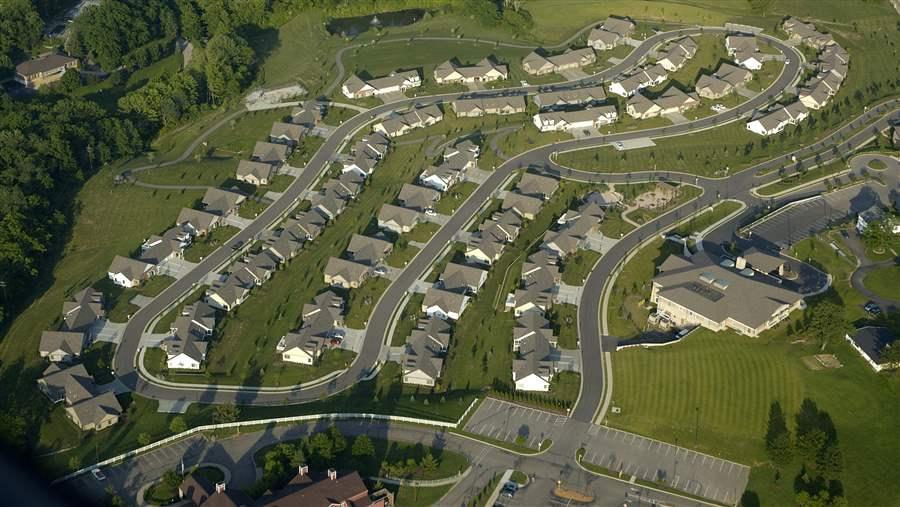A Small Town Feel and The Santa Fe Effect: Returning to the Exurbs as Rural Counties Are Fastest Growing
 © iStock
© iStock
The Great Recession stalled population growth in the exurbs. But new census data show that the far suburbs are enjoying a renaissance. They are now the fastest growing areas in the country.
Winding up Route 400, a good 40 minutes' north of Atlanta's traffic-snarled freeways, are miles of farmhouses, interspersed with mobile homes, McMansions and thrift shops. Here, too, is Dawson County's biggest draw: The North Georgia Premium Outlets, where tourists hunt for bargains at Burberry, Armani and Restoration Hardware.
Despite the designer outlets, the vibe is decidedly rural Americana. Tractors chug the roads. Masonic symbols emblazon the county government building. It’s a "small town feel" that Ginny Tarver says drew her to the area from Naples, Florida, to get married and work as an executive assistant in the county building.
Dawson is one of the fastest growing counties in Georgia and reflects a demographic shift in the nation: a return to exurbia. New census data show that for the first time since 2010, the outermost suburban counties are growing faster than urban counties and close-in suburbs, according to analysis by the Brookings Institution. People are moving back to the exurbs, some for jobs, others for bigger and more affordable homes in a more wide-open space.
"Once the economy improved, exurbs started growing," said Joel Kotkin, presidential fellow in urban futures at Chapman University. "Basically, the recession did not revolutionize human beings. As they get older, they want to own something and they want to do it with some degree of privacy. If they can do it closer to work, they do it, but the vast majority of jobs aren't in the cities."
A decade ago, the exurbs were the hot thing in real estate. Between 2005 and 2006, the peak growth period for exurbs, urban counties lost over 1.3 million people as people left for the far reaches in surrounding counties.
Young professionals in search of more affordable housing gravitated there, lured by sprawling subdivisions. Exurbs gained about 146,000 new residents through domestic migration, according to William Frey, a senior fellow at the Brookings Institution, who analyzed the new Census Bureau population estimates for counties and metro areas, which were released on March 26.
But when the housing bubble popped, so did the population growth in the outer ring suburbs. Easy credit disappeared while gasoline prices skyrocketed, making lengthy commutes unattractive. People, particularly young people, couldn't afford to move, and so they didn't, Frey said.
"There was overbuilding in the suburbs and exurbs" before the housing bubble collapsed, Frey said. "That was one extreme. Then we saw the other extreme, when everything stopped in the exurbs."
But now, exurbia is showing signs of rejuvenation, Frey said. "People are able to qualify for (mortgage loans for) homes; they're willing to take on the risk of a mortgage. Developers see that. It’s a matter of supply and demand."
The US has always been a nation of movers. For decades, about one in five people moved over a one year period, according to the US Census Bureau. Today, about one in nine moves each year.
Typically, young adults age 18 to 34 are the ones loading the U-Haul trucks, according to the census. But the Great Recession, which technically ended in 2009, stalled life transitions for many millennials who found themselves shut out of the job market and stuck in their parents’ basements, Frey said. Without stable job prospects and saddled with student loans, many young adults delayed marriage and parenthood. Buying a house became a dream deferred.
In the immediate aftermath of the recession, the number of young adults packing up and moving declined, according to the Census.
Pages: 1 · 2
More Articles
- Facing Financial Ruin as Costs Soar for Elder Care
- Stanford Medicine Study: Around age 13, Kids’ Brains Shift From Focusing on Their Mothers’ Voices to Favor New Voices
- Federal Reserve Issues A Federal Open Market Committee Statement: Committee Will Aim to Achieve Inflation Moderately Above 2% For Some Time
- Biden-Harris Administration Marks Anniversary of Americans with Disabilities Act and Announces Resources to Support Individuals with Long COVID, Increased Access to Democracy for Voters with Disabilities
- FACT SHEET: Biden-Harris Administration Delivers Funds to Support the Health of Older Americans
- What Do You Know About the Problem Solvers Caucus in the House of Representatives? They Unveiled New Bipartisan Solutions to Rebuild America’s Infrastructure, Among Other Concerns
- Coronavirus Aid, Relief, and Economic Security Act; Chair Jerome H. Powell Before the Committee on Financial Services, House of Representatives
- Consumer Financial Protection Bureau (CFPB): Lenders Cannot Discriminate Based on Sexual Orientation or Gender Identity
- Jill Norgren Reviews The Upswing: How America Came Together a Century Ago and How We Can Do It Again ... An intriguing book about change and turning points
- Kaiser Family Foundation (KFF), February 8th: This Early Stage of the COVID-19 Vaccine Roll-Out, Most Older Adults Have Not Yet Been Vaccinated As Supply Remains Limited






